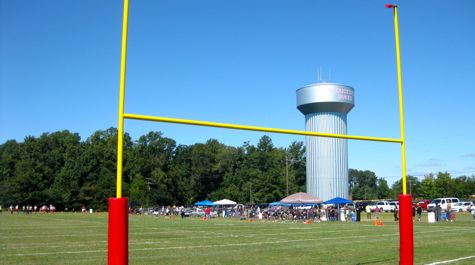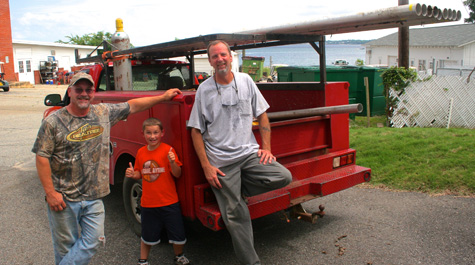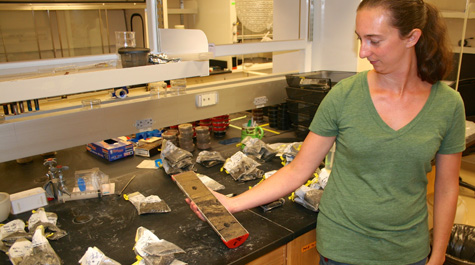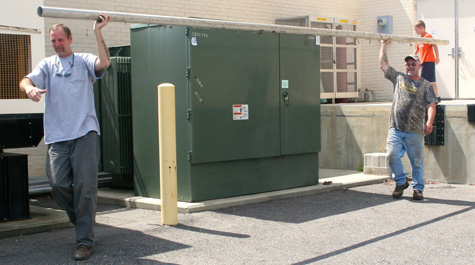VIMS helps local youth set new goals
The Virginia Institute of Marine Science recently helped local youth set some new goals, but not in the way you might think.
“We regularly help youngsters set and reach goals related to marine science through education and outreach activities such as summer camps, classroom partnerships, and tours,” says VIMS Dean and Director John Wells, “but in this case, the goals were more concrete—literally.”
Wells is referring to a donation of 10 pieces of aluminum piping from VIMS professor Steve Kuehl to local welder Billy Minter, who will use the 21-foot sections to create goal posts for the Gloucester Youth Football League.
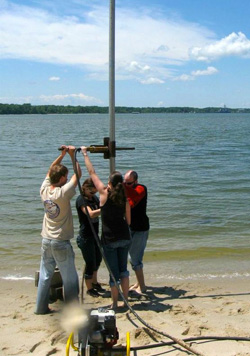
Once built, the goal posts will be set in buried concrete footers on a field behind the former site of Page Middle School. They will replace those destroyed during razing of the school site due to damage caused by the EF3 tornado that tore through Gloucester County in April 2011.
Kuehl and colleagues in the Sediment Geochronology & Seabed Processes Lab at VIMS use aluminum piping—originally fabricated for irrigation—to collect sediment cores using an instrument known as a vibracorer. As the name implies, the device uses high-frequency vibrations produced by an attached engine to drive a coring tube into seafloor sediments.
Analysis of these sediments—through visual inspection, X-rays, and other physical and chemical tests—can reveal the environmental history of a region, throwing light on long-term changes in climate, shifts in animal and plant communities, and patterns of human disturbance.
Radiometric dating of the core materials can also reveal the sediments’ age, and thus how fast sediment is accumulating in a particular area—important knowledge for government agencies tasked with keeping navigation channels open or planning oyster restoration.
Kuehl and colleagues have used their vibracorer to determine sedimentation rates during several recent projects, including a study for the Army Corps of Engineers in the Lynnhaven River, a study of the Poquoson River for York County, and an archeological study in the James River near Shirley Plantation.
But, says Kuehl, “We recently changed the design of the vibrahead on our corer, leaving us with several sections of aluminum piping of the wrong diameter. We were more than happy to donate them to Billy so that he could help out the Gloucester Youth Football League with new goal posts.”
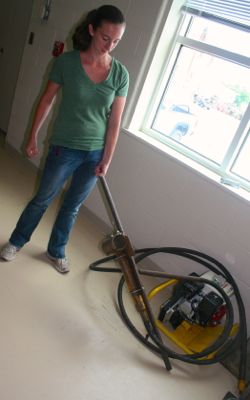 “It’s neat to think they’ll serve such a good purpose,” he adds, “Science and sports are sometimes seen as opposites, but here they’ve come together for a great cause.”
“It’s neat to think they’ll serve such a good purpose,” he adds, “Science and sports are sometimes seen as opposites, but here they’ve come together for a great cause.”
Minter, who often does welding work on vessels and laboratory equipment at VIMS, first saw the piping during a visit to VIMS’ Gloucester Point campus, and approached Ron Herzick, a project manager in VIMS’ Facilities Management Department, to ask about its status.
After checking with Kuehl, Herzick let Minter know the materials were set to be surplused, and that VIMS would be glad to donate them to the League. “They’re the perfect material for the job,” says Herzick, “both strong and light."
Volunteering to help the Gloucester Youth Football League comes naturally to Minter, who is the father of a 9-year-old lineman on the White Mighty Mites squad.
“I’m really thankful to VIMS for donating the materials,” he says. He plans to waste no time in transforming the scientific gear into goal posts and getting them erected, as the team’s first game is scheduled for August 30th.
Those wishing to add their support for local youth can turn out this Saturday, August 17, between 11-4 for GYFL Community Day, a fundraiser that will take place at the Moose Lodge in Gloucester. Proceeds from the event will help provide a concession stand for GYFL teams and the local Baystars soccer club at the new Woodville Park facility on Bray’s Point Road in Hayes. The concession stand was another item of collateral damage from the tornado that destroyed Page Middle School.


